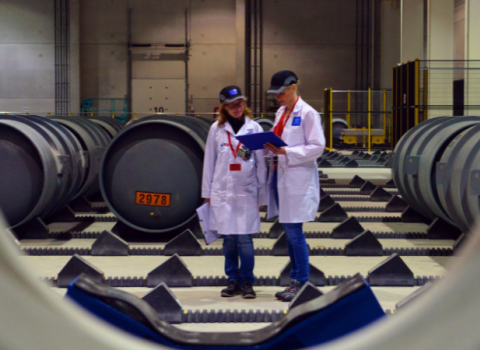Despite its massive investment in the ITER fusion project in France, the EU is home to only a tiny fraction of fusion start-ups. The technology may be far from proven, but Europe is already falling behind in preparing for commercial deployment

Fewer than one in ten of the world’s private nuclear fusion companies are based in the EU, according to a new report into the nascent industry that shows the continent falling behind the UK and US.
Fusion power is far from being ready for commercialisation, yet its promise of a potentially limitless source of relatively clean energy is attracting growing private investment from the likes of Amazon founder Jeff Bezos, fuelling a new wave of fusion start-ups across the globe.
They are trying novel approaches to harnessing nuclear fusion that could potentially leapfrog the ponderous 36-year-old ITER mega-project in the south of France, which has repeatedly been hit by delays and cost overruns.
“Private fusion is UK and US dominated,” said Andrew Holland, chief executive of the Fusion Industry Association (FIA), which helped produce the report. “This says something about different national approaches towards commercialising a technology.”
The association surveyed its members, and of those that responded to their questions, 13 are based in the US, and another five in the UK.
The EU has just three: Renaissance Fusion in Grenoble, and Marvel Fusion in Munich, and one other German fusion firm formed since the survey took place.
Canada, India, China and Australia have one private fusion firm each. In total, the FIA believes there are 35 private fusion companies in the world, though some are very early stage, and not all responded to the survey.
The EU approach is rather “dirigiste” in its plan of publicly funding the ITER fusion project, then “somehow” converting that into a commercial offering, Holland said.
“It is fair to say that the EU is lagging behind in terms of fusion start-ups,” said Greg de Temmerman, who worked as a coordinating scientist at ITER from 2014 - 2020, and is now managing director of Zenon Research, a consultancy that forecasts long-term trends.
“It might in part be due to the fact the public support to fusion research is stronger- the EU budget for fusion is much bigger than the US budget,” he said. “After all, the EU has a roadmap for fusion electricity. A few start-ups in the US started because of frustration in the lack of funding to public labs.”
In the US, private investors have backed a range of start-ups that are aiming to apply a number of different fusion technologies. Individually, they probably have “more scientific risk” than the ITER project Holland said, but taken together, the US approach is a “way of dispersing risk”.
“Of the 24 different members of the FIA, there are pretty much 24 different approaches to fusion energy,” he said.
One Canadian company is experimenting with injecting plasma into liquid lead and then compressing it with pistons. A method pioneered by the US Navy in the 1970s, it loosely resembles a giant diesel engine, said Holland.
Another member is trying out a technique involving what amount to “plasma smoke rings”, he said.
ITER has been criticised for sucking money and interest away from experimenting with these and other alternative approaches to getting nuclear fusion to work in a manageable, controlled way. This could help explain the US lead in private fusion companies, said Holland, along with a better private funding environment.
So far, private fusion start-ups report receiving $1.9 billion in funding, almost all from private backers. They are an eclectic group, including ultra-rich individuals, like Jeff Bezos and Peter Thiel; venture capital funds; Kuwait’s sovereign wealth fund; and the UK medical research charity Wellcome Trust.
Two thirds of the companies in the survey were founded in the past decade, while just over half have emerged in the last five years.
Unsurprisingly, the vast majority see one of their goals as electricity generation. But almost half also hope to deploy their fusion technology to propel spacecraft in the future.
“With all the excitement in private space, this is a growing market and fusion will play a key role,” said Holland. Chemical fuel will always be needed to escape the earth’s gravitational pull, but fusion engines could propel ships to other planets, he said.
To date, more energy has to be put in than has been got out of any fusion experiments or demonstrators, and there is no guarantee if and when any fusion technologies will actually yield a real power source.
Most companies surveyed expect the first fusion power grid in the world to emerge in the 2030s. But other experts expect this milestone to be hit in the 2040s or 2050s, and critics point to a long history of hype and over-promising.
“I think you have to be optimistic,” said Holland. “But it’s not wrong. Our companies have been able to set out their milestones. If they don’t meet their milestones, they don’t get funding.”
The association is now lobbying for government investment in its fusion companies. Moritz von der Linden, founder of Marvel Fusion in Germany, said that the country needed to “ramp up their political support for all kinds of fusion technologies, including laser-based fusion technologies to not fall behind the USA, China, or the UK and to maintain its role as one of the European powerhouses.”
There is no specific state support for private fusion companies yet, Holland noted, but the European Commission recently made contact with the association to begin a regular dialogue.
The EU has been in regular dialogue with the European fusion industry for several years, an EU official said, and has been in contact with the Fusion Industry Association since earlier this year.
While there is no EU financial backing for private fusion projects at the moment, they acknowledged, such funding could be possible in the future if there would be specific EU fusion priorities that private fusion companies could address.
This article has been updated to include a response from an EU official.





 A unique international forum for public research organisations and companies to connect their external engagement with strategic interests around their R&D system.
A unique international forum for public research organisations and companies to connect their external engagement with strategic interests around their R&D system.